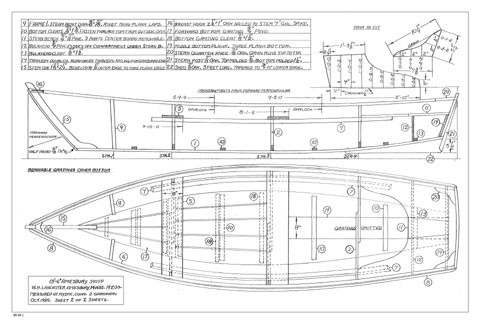Quick canoe plans download
Wednesday, August 6, 2025
Free Wooden Boat Plans for DIY Enthusiasts on a Budget
Carve Your Own Adventure: Free Wooden Boat Plans for Budget-Conscious Builders
The allure of the open water, the satisfying creak of wood under your hands, the pride of building something with your own two hands – these are the dreams that fuel countless DIY enthusiasts. But the cost of boat building can often sink even the most ambitious projects before they begin. Fear not, aspiring shipwrights! This article unveils a treasure trove of free wooden boat plans, allowing you to navigate the waters of boat construction without breaking the bank. Prepare to embark on an exciting journey, turning your woodworking passion into a floating reality.
Choosing the Right Plan for Your Skillset
Before you dive into the world of free boat plans, consider your skill level. Many resources offer plans ranging from simple, beginner-friendly designs to complex projects suitable for experienced woodworkers. Don't overestimate your abilities. Starting with a smaller, simpler boat allows you to gain valuable experience and build confidence before tackling more challenging designs. Carefully examine each plan's specifications, paying close attention to the materials list, tool requirements, and detailed instructions. Look for plans with clear diagrams, detailed explanations, and plenty of photos to guide you through each stage of construction.
Beginner-Friendly Options:
Beginners should prioritize simple designs like small rowboats or canoes. These plans often feature straightforward construction techniques and readily available materials. Look for plans that utilize readily available lumber such as plywood or cedar. A well-constructed small rowboat or kayak can provide hours of enjoyment on calm waters and serve as an excellent stepping stone to more complex projects.
Intermediate and Advanced Projects:
For more experienced builders, the possibilities expand dramatically. You can explore plans for larger boats, sailboats, or even more intricate designs. Remember to carefully assess the complexity of the joinery, hull shape, and overall construction before selecting a plan. Always prioritize safety – building a seaworthy vessel requires meticulous attention to detail and precise execution.
Finding Reputable Sources for Free Wooden Boat Plans
The internet is a vast ocean of information, and finding reliable free boat plans requires careful navigation. Avoid sites that offer plans with vague instructions or incomplete diagrams. Look for websites and online communities dedicated to woodworking and boat building. These communities often share their expertise, provide valuable advice, and host extensive archives of free plans.
Where to Find Reliable Plans:
- Online Forums and Communities: Engage with experienced boat builders who frequently share their plans and offer guidance.
- Websites Dedicated to Boat Building: Many websites provide free plans, but always verify their reputation and check user reviews before downloading anything.
- Public Libraries and Archives: Surprisingly, some libraries hold collections of older boat building books that might contain free or public domain plans.
Beyond the Plans: Essential Considerations for Success
Free plans are a fantastic starting point, but successful boat building requires more than just blueprints. You'll need to carefully source high-quality lumber, invest in the necessary tools (or borrow them from friends!), and familiarize yourself with essential woodworking techniques. Planning your project meticulously – from material acquisition to construction timeline – significantly increases your chances of building a safe and enjoyable boat. Remember to factor in the time needed – boat building is a rewarding, but often time-consuming, endeavor.
Building your own wooden boat is a challenging yet deeply satisfying project. By choosing the right plans, sourcing materials carefully, and approaching the project with patience and persistence, you can realize your dream of owning a beautiful, handcrafted vessel – all while keeping your budget afloat!
Luxury Wooden Boat Plans for High-End Craftsmanship
Luxury Wooden Boat Plans for High-End Craftsmanship
Introduction: The Allure of Wooden Boatbuilding
For centuries, the art of wooden boatbuilding has captivated artisans and enthusiasts alike. The inherent beauty of the wood, the meticulous craftsmanship required, and the timeless elegance of the finished product combine to create a unique and rewarding experience. This article delves into the intricacies of designing and constructing luxury wooden boats, focusing on the high-end aspects that distinguish these vessels from mass-produced counterparts. We will explore various design considerations, material selection, construction techniques, and the crucial role of skilled craftsmanship in achieving an exceptional final product. The pursuit of excellence in wooden boatbuilding is a journey demanding precision, patience, and an unwavering commitment to quality. This detailed guide serves as a roadmap for those seeking to embark on such a rewarding endeavor.
Design Considerations for Luxury Wooden Boats
The design phase is paramount in ensuring the success of a luxury wooden boat project. A well-conceived design lays the foundation for both aesthetic appeal and structural integrity. Several crucial aspects must be considered:
Hull Design and Hydrodynamics:
The hull design dictates the boat's performance characteristics. For luxury vessels, optimal hydrodynamic efficiency is essential. This requires careful consideration of factors such as displacement, waterline length, beam, and deadrise. Advanced computational fluid dynamics (CFD) analysis can be employed to refine the hull shape and minimize resistance, resulting in improved speed and fuel efficiency. The choice of hull form—whether a traditional displacement hull, a semi-displacement hull, or a planing hull—will depend on the intended use and desired performance characteristics.
Structural Integrity and Material Selection:
Structural integrity is paramount, especially in larger, luxury vessels. The design must account for the stresses imposed by waves, wind, and the weight of the boat and its occupants. Careful selection of timber species is crucial. High-strength woods such as teak, mahogany, and cedar are commonly employed, but their properties vary depending on the specific source and growth conditions. The designer must consider the properties of each wood species and select the optimal material for each structural component to ensure long-term durability and resistance to decay and marine borers.
Aesthetics and Styling:
Luxury wooden boats are not merely functional vessels; they are also works of art. The design must incorporate aesthetic elements that reflect the owner's taste and preferences while maintaining a harmonious overall appearance. Classical designs, with their graceful lines and elegant proportions, often serve as a source of inspiration. However, contemporary aesthetics can also be effectively incorporated, resulting in a unique and visually stunning vessel.
Interior Layout and Amenities:
The interior layout of a luxury wooden boat requires careful planning to maximize space and functionality while providing a comfortable and luxurious environment for the occupants. High-quality joinery, carefully chosen fabrics, and luxurious fittings are all essential elements. Consideration should be given to features such as climate control, sound systems, galley facilities, and sleeping accommodations to create a truly refined and comfortable onboard experience. The design should prioritize both practicality and aesthetic appeal.
Material Selection and Preparation
The quality of the materials used directly impacts the final product's longevity and aesthetic appeal. Selecting appropriate timber species and ensuring proper preparation are vital steps.
Timber Selection:
The choice of timber depends on factors such as strength, durability, workability, and aesthetic appeal. Teak, with its exceptional durability and resistance to rot and marine borers, is a popular choice for exterior planking and decking. Mahogany, known for its rich color and beautiful grain, is often used for interior joinery and paneling. Cedar, with its light weight and resistance to decay, is suitable for various structural components. The source and quality of the timber are crucial factors influencing its long-term performance.
Timber Treatment and Preparation:
Proper treatment and preparation of the timber are essential for preventing rot, decay, and insect infestation. This often involves kiln-drying to reduce moisture content, followed by application of protective coatings such as marine-grade varnish or epoxy. Careful attention to detail during this stage prevents future problems and ensures the longevity of the finished vessel. The methods used must meet the highest standards for environmental sustainability and safety.
Hardware and Fittings:
High-quality hardware and fittings are indispensable for a luxury wooden boat. These should be selected for both their functionality and their aesthetic contribution to the overall design. Marine-grade stainless steel is the preferred material for many components, due to its resistance to corrosion. The selection of hardware should reflect the overall style and design philosophy of the vessel, ensuring a cohesive and harmonious aesthetic.
Construction Techniques and Craftsmanship
The construction process demands meticulous attention to detail and a high level of craftsmanship. Traditional techniques, combined with modern advancements, ensure structural integrity and aesthetic excellence.
Traditional Boatbuilding Methods:
Traditional boatbuilding techniques, such as plank-on-frame construction, offer a blend of artistry and engineering. Each plank is carefully shaped and fitted to the ribs, creating a strong and durable hull. The process requires skilled craftsmanship and a deep understanding of woodworking principles. These time-honored methods result in vessels with unique character and timeless appeal.
Modern Techniques and Technologies:
Modern techniques, such as computer-aided design (CAD) and computer-aided manufacturing (CAM), can be integrated into the construction process to enhance accuracy and efficiency. These tools assist in creating precise templates and components, facilitating smoother assembly and minimizing waste. However, the core of the process remains the skilled hands of the artisan, ensuring a seamless blend of tradition and innovation.
Finishing and Detailing:
The final stages of construction involve meticulous finishing and detailing. This includes sanding, fairing, and applying multiple coats of high-quality marine varnish or other protective coatings to enhance both the beauty and durability of the boat's exterior. Interior finishes are equally critical, with careful attention paid to joinery, upholstery, and the selection of luxurious fabrics and fittings to create a refined and comfortable interior space.
Conclusion: The Legacy of Luxury Wooden Boatbuilding
Building a luxury wooden boat is a significant undertaking, demanding not only exceptional technical skills but also a deep appreciation for the artistry and tradition involved. The meticulous attention to design, material selection, construction techniques, and finishing details ensures a lasting legacy. The resulting vessel is not merely a means of transportation; it is a testament to the enduring power of craftsmanship, a floating work of art destined to become a treasured possession for generations to come. The investment in time, effort, and resources is matched by the unparalleled satisfaction of owning and operating a truly exceptional wooden boat.
Thursday, November 5, 2020
John gardner dory plans Benefit
Photos John gardner dory plans



Coast guard response boat small manual Best price
Pic Example Coast guard response boat small manual

Wednesday, November 4, 2020
How to eskimo roll a canoe Savings
Imagery How to eskimo roll a canoe



Boat building wood plans Achieve
Foto Results Boat building wood plans



Boat plan software Closeout
Imagery Boat plan software







